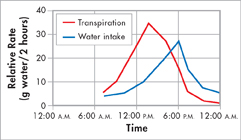23.5 Transport in Plants
Understand Key Concepts
The rise of water in a tall plant depends on capillary action and
osmosis.
evaporation.
nutrient transport.
transpirational pull.
The pressure-flow hypothesis explains
water movement in xylem.
water and nutrient movement in phloem.
water and nutrient movement in xylem.
water movement in phloem.
Attraction between water molecules and other substances is
adhesion.
capillary action.
transpiration.
cohesion.
What is the main function of phloem?
What are source cells and sink cells?
Think Critically
Relate Cause and Effect Would transpirational pull be stronger on a hot, humid day or on a hot, dry day? Explain.
Apply Concepts Why are maple trees tapped for their sugar in the early spring rather than in the summer or autumn?
Connecting Concepts
Use Science Graphics
Use the graph to answer questions 38–40.
Analyze Data During which span of time is the greatest amount of water lost through transpiration?
Analyze Data About how many grams of water are lost every two hours when the transpiration curve is at its highest peak?
Draw Conclusions What is the relationship between transpiration and water intake?
Write About Science
Explanation Explain how the cells in the vascular tissue of a root are specialized for transport of water and minerals.
Assess the
 Describe how several different tissue types in a leaf work together to support a functioning plant organ.
Describe how several different tissue types in a leaf work together to support a functioning plant organ.
Analyzing Data
A scientist selects a single three-year-old birch tree to study growth patterns. She inserts a nail into the trunk 1.0 m above ground level. At intervals over the next 15 years, she measures the total height of the tree and the circumference of the tree at the point where the nail is sticking out. She records the results, which are shown here.
Interpret Tables In which time interval was tree growth the greatest?
0 to 3 years
3 to 8 years
8 to 13 years
13 to 18 years
Calculate What was the average growth in the height of the tree from sprouting to age 18?
0.2 meters per year
0.5 meters per year
1.0 meters per year
2.0 meters per year
Table of Contents
- Formulas and Equations
- Applying Formulas and Equations
- Mean, Median, and Mode
- Estimation
- Using Measurements in Calculations
- Effects of Measurement Errors
- Accuracy
- Precision
- Comparing Accuracy and Precision
- Significant Figures
- Calculating With Significant Figures
- Scientific Notation
- Calculating With Scientific Notation
- Dimensional Analysis
- Applying Dimensional Analysis






